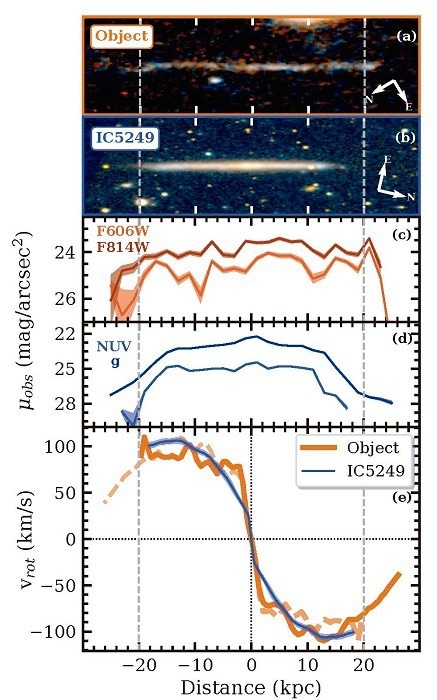A study performed by a research group at the Instituto de Astrofísica de Canarias (IAC) has shown that a strange thin structure of stars, which has been recently found by the Hubble Space Telescope, could be a galaxy seen edge-on.

Comparison between this “object” and an edge-on galaxy in the local Universe (IC5249): images (a and b) the intensity along the track (c and d) and its rotational velocity (e). This object and IC5249 turn out to be extremely similar in all their physical parameters, which supports the idea that the “object” is really an edge-on galaxy. Image Credit: Instituto de Astrofísica de Canarias
This discovery goes against the original interpretation in which an escaping supermassive black hole was exiting a trail of stars in its wake. The new interpretation has been reported in the journal Astronomy and Astrophysics Letters.
Around eight thousand million years ago, a puzzling trail of stars developed and was recently discovered by the Hubble Space Telescope. Its size is identical to that of the Milky Way, and this very long narrow structure has been a source of numerous debates.
As per a controversial initial hypothesis, this trail of stars could be the outcome of the passage of a supermassive black hole via a huge cloud of gas.
This concept rapidly fired the imagination of the astronomical community, as it requires a huge set of complicated outstanding circumstances. Many scientific groups have continued to explore various and less strange scenarios which could describe the observations.
In a new study performed, scientists at the IAC have attained the conclusion that this uncommon structure of stars could be taken as a galaxy without a bulge seen edge-on. This kind of galaxy, also known as a thin or flat galaxy, is comparatively common.
The motions, the size, and the quantity of stars fits what has been seen in galaxies within the local universe. It’s a relief to have found the solution to this mystery, the new proposed scenario is much simpler. In one sense it is also a pity, because the existence of fleeing black holes is expected, and this could have been the first one to be observed.
Jorge Sanchez Almeida, Study First Author and Researcher, Instituto de Astrofísica de Canarias
To aid the hypothesis of the interpretation concerning the galaxy, the team made a comparison of the puzzling structure with a renowned local galaxy without a bulge, IC5249, which consisted of a similar mass of stars, and discovered a surprising agreement.
When we analyzed the velocities of this distant structure of stars we realized that they were very similar to those obtained from the rotation of galaxies, so we decided to compare a much closer galaxy, and found that they are extraordinarily similar.
Mireia Montes, Study Co-Author and Researcher, Instituto de Astrofísica de Canarias
“We also looked at the relation between the mass of the assumed galaxy and its máximum velocity of rotation, and discovered that indeed it is a galaxy which behaves like a galaxy. It is an interesting object, because it is quite a large galaxy at a very large distance from Earth, where the majority of the galaxies are smaller,” states Ignacio Trujillo, an IAC researcher who has participated in the study.
Upcoming observations will allow the study of this object in greater detail.
Journal Reference
Almeida, J. S., et al. (2023) Supermassive black hole wake or bulgeless edge-on galaxy?. Astronomy & Astrophysics. doi.org/10.1051/0004-6361/202346430